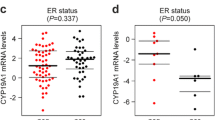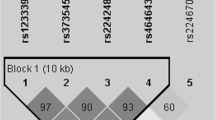Abstract
Due to the established association between estrogen levels and breast cancer risk, polymorphic variation in genes regulating estrogen levels is thought to be related to breast cancer risk. Aromatase, the protein product of the CYP19 gene, is involved in the production of endogenous estrogens via androgen conversion. We examined whether polymorphic variation in CYP19 associated with increased breast cancer risk in a population based case-control study. We examined two single nucleotide polymorphisms (SNP), rs1008805 (A/G) and rs730154 (C/T), which have been shown to tag SNPs within two different haplotype blocks in CYP19. Among premenopausal women, the presence of at least one G allele at rs1008805 was significantly associated with an increase in the risk of breast cancer (OR = 1.72 [95% CI, 1.20–2.49]), especially with estrogen and progesterone receptor negative breast cancer (OR = 3.89 [1.74–8.70] and OR = 2.52 [1.26–5.05], respectively). No association was observed among postmenopausal women (OR = 1.06 [0.82–1.36]). There was no significant association between rs730154 and breast cancer, regardless of menopausal status. Our results suggest that premenopausal women carrying the G allele at CYP19 rs1008805 have increased risk of breast cancer. The finding supports the potential role of variation in estrogen biosynthesis genes in premenopausal breast cancer risk.
Similar content being viewed by others
References
Mahendroo MS, Means GD, Mendelson CR et al (1991) Tissue-specific expression of human P450 AROM. J Biol Chem 266(17):11276–11281
Hunter DJ, Willett WC (1993) Diet, body size, and breast cancer. Epidemiol Rev 15(1):110–132
Bulun S, Lin Z, Imir G et al (2005) Regulation of aromatase expression in estrogen-responsive breast and uterine disease: from bench to treatment. Pharmacol Rev 57:359–383
Chetrite G, Cortes-Prieto J, Philippe J et al (2000) Comparison of estrogen concentrations, estrone sulfatase and aromatase activities in normal, and in cancerous, human breast tissues. J Steroid Biochem Mol Biol 72(1–2):23–27
Tekmal R, Kirma N, Gil K et al (1999) Aromatase overexpression and breast hyperplasia, an in vivo model–continued overexpression of aromatase is sufficient to maintain hyperplasis without circulating estrogens, and aromatase inhibitors abrogate these preneoplastic changes in mammary glands. Endocrine-Related Cancer 6(2):307–314
Goss PE, Strasser K (2001) Aromatase inhibitors in the treatment and prevention of breast cancer. J Clin Oncol 19(3):881–894
Somner J, McLellan S, Cheung J et al (2004) Polymorphisms in the P450 c17 (17-Hydroxylase/17,20-Lyase) and P450 c19 (Aromatase) Genes: Association with Serum Sex Steroid Concentrations and Bone Mineral Density in Postmenopausal Women. J Clin Endocrinol & Metabol 89(1):344–351
Carani C, Qin K, Simoni M et al (1997) Effect of testosterone and estradiol in a man with aromatase deficiency. New Engl J Med 337(2):91–95
Ito Y, Fisher CR, Conte FA et al (1993) Molecular basis of aromatase deficiency in an adult female with sexual infantalism and polycystic ovaries. Proc Natl Acad Sci USA 90(24):11673–11677
Morishima A, Grumbach MM, Simpson ER et al (1995) Aromatase deficiency in male and female siblings caused by a novel mutation and the physiological role of estrogens. J Clin Endocrinol Metabol 80(12):3689–3698
Mullis PE, Yoshimura N, Kuhlman B et al (1997) Aromatase deficiency in a female who is compound heterozygote for two new point mutations in the P450arom gene: impact of estrogens on hypergonadotropic hypogonadism, multicystic ovaries, and bone densitometry in childhood. J Clin Endocrinol Metabol 82(6):1739–1745
Henderson B, Feigelson H (2000) Hormonal carcinogenesis. Carcinogenesis 21(3):427–433
Haiman CA, Hankinson SE, Spiegelman D et al (2000) A tetranucleotide repeat polymorphism in CYP19 and breast cancer risk. Int J Cancer 87(2):204–210
Healey CS, Dunning AM, Durocher F et al (2000) Polymorphisms in the human aromatase cytochrome P450 gene (CYP19) and breast cancer risk. Carcinogenesis 21(2):189–193
Kristensen VN, Andersen TI, Lindblom A et al (1998) A rare CYP19 (aromatase) variant may increase the risk of breast cancer. Pharmacogenetics 8(1):43–48
Probst-Hensch NM, Ingles SA, Diep AT et al (1999) Aromatase and breast cancer susceptibility. Endocrine-Related Cancer 6(2):165–173
Siegelmann-Danieli N, Buetow KH (1999) Constitutional genetic variation at the human aromatase gene (CYP19) and breast cancer risk. Brit J Cancer 79(3–4):456–463
Ahsan H, Whittemore AS, Chen Y et al (2004) Variants in estrogen-biosynthesis genes CYP17 and CYP19 and breast cancer risk: a family-based genetic association study. Breast Cancer Res 7(1):R71–R81
Baxter SW, Choong DY, Eccles DM et al (2001) Polymorphic variation in CYP19 and the risk of breast cancer. Carcinogenesis 22(2):347–349
Dunning AM, Dowsett M, Healey CS et al (2004) Polymorphisms associated with circulating sex hormone levels in postmenopausal women. J Natl Cancer Inst 96(12):936–945
Hirose K, Matsuo K, Toyama T et al (2004) The CYP19 gene codon 39 Trp/Arg polymorphism increases breast cancer risk in subsets of premenopausal Japanese. Cancer Epidemiol Biomark Prev 13(8):1407–1411
Miyoshi Y, Iwao K, Ikeda N et al (2000) Breast cancer risk associated with polymorphism in CYP19 in Japanese women. Int J Cancer 89(4):325–328
Thyagarajan B, Brott M, Mink P et al (2004) CYP1B1 and CYP19 gene polymorphisms and breast cancer incidence: no association in the ARIC study. Cancer Lett 207(2):183–189
Haiman CA, Stram DO, Pike MC et al (2003) A comprehensive haplotype analysis of CYP19 and breast cancer risk: the Multiethnic Cohort. Hum Mol Genet 12(20):2679–2692
Gammon MD, Neugut AI, Santella RM et al (2002) The Long Island Breast Cancer Study Project: description of a multi-institutional collaboration to identify environmental risk factors for breast cancer. Breast Cancer Res Treat 74(3):235–254
Stephens M, Smith N, Donnelly P (2001) A new statistical method for haplotype reconstruction from population data. Am J Hum Genet 68(4):978–989
Stephens M, Donnelly P (2003) A comparison of Bayesian methods for haplotype reconstruction from population genotype data. Am J Hum Genet 73(5):1162–1169
Chong Y, Colston K, Jiang W et al (2006) The relationship between the insulin-like growth factor-1 system and the oestrogen metabolising enzymes in breast cancer tissue and its adjacent non-cancerous tissue. Breast Cancer Res Treat 99:275–288
Hankinson S, Willett W, Colditz G et al (1998) Circulating concentrations of insulin-like growth factor I and risk of breast cancer. Lancet 351:1393–1396
Pharoah PD, Dunning AM, Ponder BAJ et al (2004) Association studies for finding cancer-susceptibility genetic variants. Nat Rev Cancer 4(11):850–860
Bond GL, Hu W, Bond EE et al (2004) A Single Nucelotide Polymorphism in the MDM2 PromoterAttenuates the p53 Tumor Supressor Pathway and Accellerates Tumor Formation in Humans. Cell 119:591–602
Skorupski P, Krol J, Starega J et al (2006) An alpha-1 chain of type 1 collagen Sp1-binding site polymorphism in women suffering from stress urinary incontinence. Am J Obstet Gynecol 194(2):346–350
Lian K, Zmuda JM, Nevitt MC et al (2005) Type I collagen alpha1 Sp1 transcription factor binding site polymorphism is associated with reduced risk of hip osteoarthritis defined by severe joint space narrowing in elderly women. Arthritis Rheum 52(5):1431–1436
Duan J, Wainwright MS, Comeron JM et al (2003) Synonymous mutations in the human dopamine receptor D2 (DRD2) affect mRNA stability and synthesis of the receptor. Hum Mol Genet 12(3):205–216
Jin Y, Dietz HC, Montgomery RA et al (1996) Glanzmann thrombasthenia. Cooperation between sequence variants in cis during splice site selection. J Clin Invest 98(8):1745–1754
Chen X, Truong TT, Weaver J et al (2006) Intronic alterations in BRCA1 and BRCA2: effect on mRNA splicing fidelity and expression. Hum Mutat 27(5):427–435
International HapMap Project. http://www.hapmap.org
Haiman CA, Dossus L, Setiawan VW et al (2007) Genetic variation at the CYP19A1 locus predicts circulating estrogen levels but not breast cancer risk in postmenopausal women. Cancer Res 67(5):1893–1897
Acknowledgements
Funded in part by grants U01 CA/ES66572, P30ES09089, and P30ES10126 from the National Cancer Institute and the National Institute of Environmental Health Sciences, a grant from the Cancer Research Foundation, and gifts from private citizens. We thank the following people for their valuable contributions to the Long Island Breast Cancer Study Project: members of the Long Island Breast Cancer Network; the thirty-one participating institutions on Long Island and in New York City, NY; our NIH collaborators, Gwen Colman, Ph.D., National Institutes of Environmental Health Sciences; G. Iris Obrams, M.D., Ph.D., formerly of the National Cancer Institute; members of the External Advisory Committee to the population based case-control study: Leslie Bernstein, Ph.D. (Committee Chair); Gerald Akland, M.S.; Barbara Balaban, M.S.W.; Blake Cady, M.D.; Dale Sandler, Ph.D.; Roy Shore, Ph.D.; and Gerald Wogan, Ph.D.; as well as other collaborators who assisted with various aspects of our data collection efforts including Gail Garbowski, M.P.H., Julie Britton, Ph.D., Mary S. Wolff, Ph.D., Steve Stellman, Ph.D., Maureen Hatch, Ph.D., Geoff Kabat Ph.D., Bruce Levin, Ph.D. H. Leon Bradlow, Ph.D.; David Camann, B.S.; Martin Trent, B.S.; Ruby Senie, Ph.D.; Carla Maffeo, Ph.D.; Pat Montalvan; Gertrud Berkowitz, Ph.D.; Margaret Kemeny, M.D.; Mark Citron, M.D.; Freya Schnabel, M.D.; Allen Schuss, M.D.; Steven Hajdu, M.D.; and Vincent Vinceguerra, M.D.
Author information
Authors and Affiliations
Corresponding author
Rights and permissions
About this article
Cite this article
Talbott, K.E., Gammon, M.D., Kibriya, M.G. et al. A CYP19 (aromatase) polymorphism is associated with increased premenopausal breast cancer risk. Breast Cancer Res Treat 111, 481–487 (2008). https://doi.org/10.1007/s10549-007-9794-2
Received:
Accepted:
Published:
Issue Date:
DOI: https://doi.org/10.1007/s10549-007-9794-2




